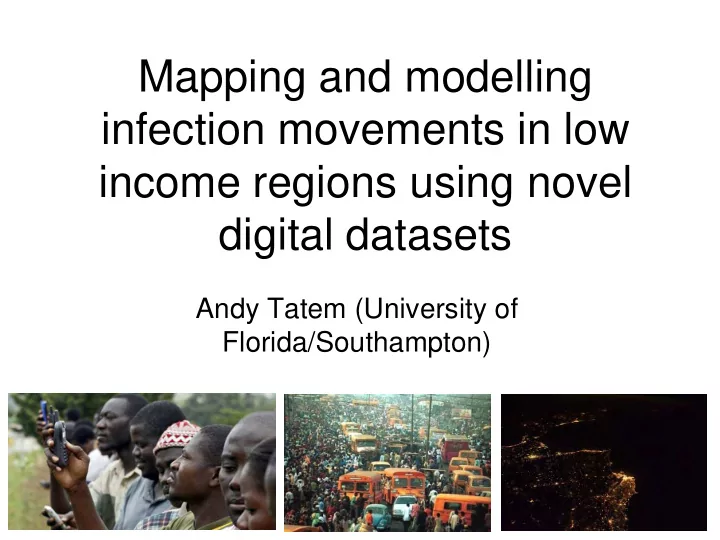

Mapping and modelling infection movements in low income regions using novel digital datasets Andy Tatem (University of Florida/Southampton)
Human mobility
Human movements and disease Stoddard, Morrison, Vazquez-Prokopec et al (2009) PLoS Negl.Trop.Dis
Pre-21 st Century....
The last decade: high income regions Brockmann, Hufnagel, Geisel (2006) Nature Pybus, Suchard, Lemey et al (2012) PNAS Tatem, Huang, Das et al (2012) Parasitology
The last decade: low income regions
Malaria elimination / eradication
National malaria plans
‘Vulnerability’ • Before elimination, conduct a feasibility assessment Technical feasibility of elimination: Receptivity + Vulnerability Vulnerability: the influx of infected individuals and/or anophelines
Le Menach, Tatem, Cohen et al (2011) Nature Scientific Reports Cosner, Beier, Cantrell et al (2009) J Theoretical Biology
Mobile phone usage data X User makes a call Network operator Call routed through from location X records time and nearest tower tower of call for billing Y User travels to Y and makes a call
Mobile phone usage data Advantages -Massive sample size, impossible to achieve with travel history surveys - National-scale data - Relatively reliable source of destinations and lengths of stay for travel Disadvantages -Bias in representation of national population movements - No cross-border movement information - No demographic information - No information on activities, malaria protection etc during travel -Difficult to access and impossible to share
Importation rate Sources and sinks Where are the likely sources of How many infections are being imported infections? Where are they imported? When? From where? going? Communities Targetting Where is community X most likely to How can we make efficient use of import/export infections from/to? these data to target surveillance and control?
Zanzibar malaria importation ? ? ?
Movement patterns Tatem, Qiu, Smith et al (2009) Malaria Journal
Heterogeneous biting Person visits Population − 1 α ( ) δ r = N r 1 − 1 + α bET r Length of No. imported stay infections Transmission efficiency Transmission seasonality Le Menach, Tatem, Cohen et al (2011) Nature Scientific Reports Tatem, Qiu, Smith et al (2009) Malaria Journal
Seasonal movements in the Sahel • Dry season sees substantial migration to major cities from northern arid regions • This, combined with movements from countries to the south drives country-wide measles epidemics Bharti, Djibo, Ferrari et al (2010) Epidemiology and Infection
Agnew, Gillespie, Gonzalez et al (2008) Environment and Planning A
Seasonal movements to/from Niamey • Can we measure the timing and relative size of the incoming migration using satellite night-lights? • Can we use this information to drive a model of measles transmission? Bharti, Tatem, Ferrari et al (2011) Science
Bharti, Tatem, Ferrari et al (2011) Science
Summary: human mobility • Datasets and methods to aid understanding of mobility patterns in low income regions are increasingly becoming available • Nightlights offers potential for providing quantitative info on epidemiologically important seasonal migrations • Cell phone usage data can provide a rich datasource for quantifying movement patterns – but significant data sharing restrictions means there is a need for open access generic models of human movement built using these datasets
The Human Mobility Mapping Project • Open access models of human movement built on the AfriPop/AsiaPop framework • Short-term movements: GPS and mobile phone usage data (Kenya, Tanzania, Namibia, Rwanda, Indonesia, Dominican Republic) • Medium/long-term movements: Microdata and survey movement patterns • Largescale seasonal movements: Satellite night-time light fluctuations www.thummp.org
The Future • Intercomparison & validation of different mobility datasets • Models integrated with disease models and AfriPop, AsiaPop, AmeriPop frameworks • Development of nightlights- driven near real-time assessments • Landscape phylodynamics
Acknowledgements Dave Smith, Arnaud le Menach (Johns Hopkins), Deepa Pindolia, Andres Garcia, Youliang Qiu, Zhuojie Huang, Udayan Kumar (UF), Simon Hay, Pete Gething (Univ. Oxford), Robert Snow, Abdisalan Noor (Kenya Medical Research Institute), Abdullah Ali (ZMCP), Bruno Moonen, Justin Cohen, Chris Lourenco, Deepika Kandula (Clinton Foundation), Nita Bharti, Matt Ferrari (Penn State), Bryan Grenfell (Princeton), Caroline Buckee (Harvard), Amy Wesolowski (Carnegie Mellon), Nathan Eagle (MIT), Alex Perkins, Tom Scott (UC Davis), Gonzalo Prokopec (Emory)
Further information www.thummp.org www.afripop.org www.asiapop.org www.vbd-air.com www.ameripop.org www.map.ox.ac.uk E-mail: Andy.Tatem@gmail.com
Recommend
More recommend